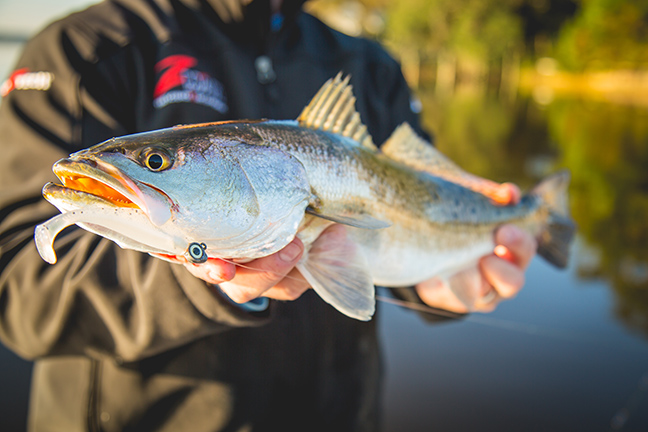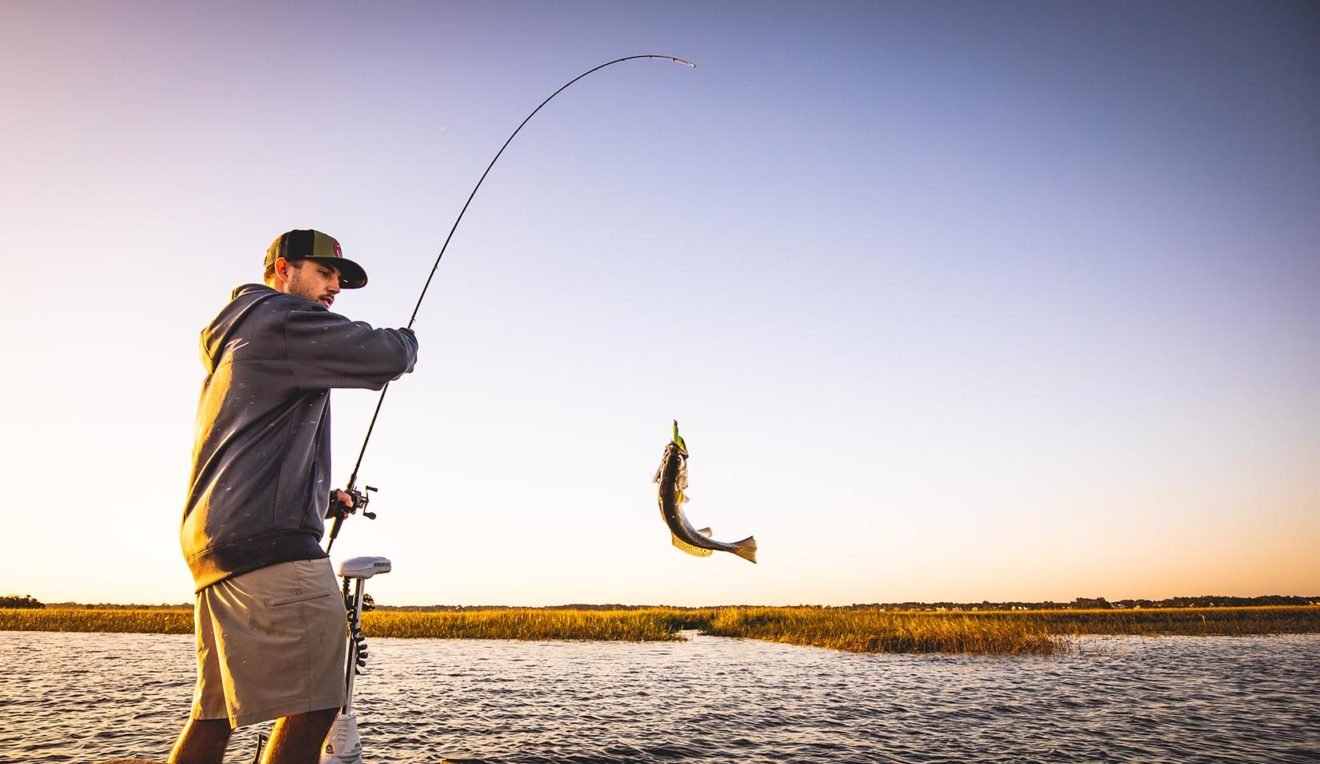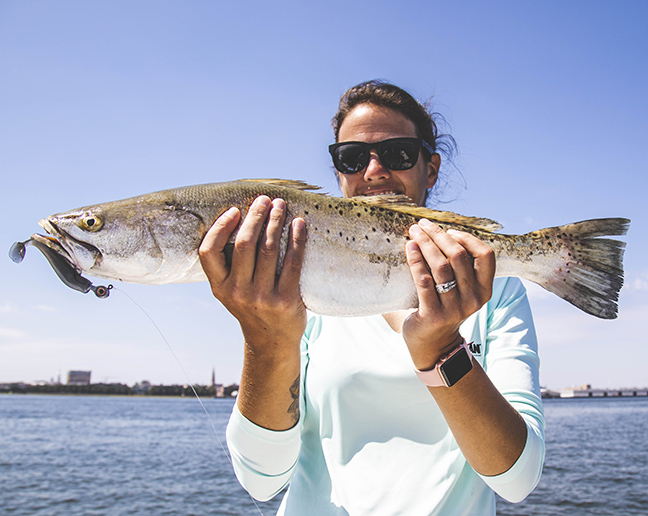Does Jig Color Matter?
Fishing is a lifelong experiment. If your personal experimental journey stalls or plateaus, rest assured you’re missing out on gear innovations and developments in techniques that catch fish. Music is similar. Generations call it quits and get rutted in an era, never giving new music a chance to expand their listening. You don’t need to embrace rap, but there’s a world of music out there.
This same phenomenon occurs with lure colors, jigs specifically. Everyone has a comfort zone, clinging to colors that have performed in the past, never considering the unique conditions at hand. Just because green has produced before, doesn’t mean it will when circumstances change, especially water clarity. Same goes for body design. You probably started with conventional curly-tails, but hopefully didn’t stop there. Modern lure crafters can emulate the profile, size, and locomotion of every baitfish that swims.
In the spirit of utilizing contemporary designs, I fished Z-Man’s MinnowZ exclusively in the following narrative. It’s a beautifully profiled bait with a tremendous thumping action, and as importantly, comes in a wealth of colors, 53 to be exact.
Seatrout were the primary target. The voracious gamefish are staunch sight-feeders with the ability to acutely discern colors. They own the visual acuity of humans. For more on that topic, an intensive study was conducted on the Chesapeake Bay in 2009 to substantiate this premise.
For my analysis, the laboratory was a channel between the Gulf of Mexico and expansive bays with adjacent saltwater flats. Within the channel is a significant outcropping, a jumbo cove, which is affected by incoming and outgoing tides, but not subject to the primary flow. With that said, tidal movements are evidenced by current seams, water coloration and clarity shifts, all of which contribute to where seatrout are located and what colors they react to. It’s not uncommon to confront a half dozen unique conditions on a single outing.
Being guided by vision, seatrout typically errs toward cleaner water, especially along seams with water coloration changes. Using clarity as their guide, coupled with the seatrout’s exceptional vision, it’s reasonable to assume that natural colors would perform best. And they do.
Colors, actually blended colors that replicated baitfish, were the ticket. With a Z-Man MinnowZ, that meant baitfish hues like The Deal, Mulletron and Smelt. Worked along the described seam, seatrout responded aggressively.
But soon, an outgoing tide pushed murkier water out of the bays, into the channel and cove, and that clearcut seam mutated into a cove of darkness. Simultaneously, the bite ended on natural toned bodies. So, either the trout had vacated, the seatrout’s color preferences changed, or baits simply became harder to see.
Swapping to darker patterns quickly proved that the fish hadn’t left and were still feeding. What might seem counterintuitive is that darker colors work well in dark water. They cast distinct silhouettes, even more so than actual baitfish, making them extra visible. Good choices in darker water are a MinnowZ in Rootbeer/Gold, California Craw, and Purple Demon.
Sidebar on the color red: The same Chesapeake Bay study cited earlier also determined that red is the most visible in a seatrout’s color spectrum. In the overall bandwidth of colors, red loses its color with distance faster than most, but is the most pronounced at short range. This intel supports the popularity of Z-Man’s Houdini, which features red highlights on natural tones, or the even redder Calico Candy.
Abrupt two-tones are another viable option in dark water, particularly something with a bright paddle like Z-Man’s Morning Glory and Rootbeer/Chartreuse Tail. Jig bodies featuring a dark torso and chartreuse tail are perennial inshore fish catchers, coast to coast.
Seatrout also become more stationary in dark water, meaning less apt to chase. Plan on making extra casts and covering more water, methodically. A slower retrieve is suggested, too. Baitfish tend to move less in dark water, assumedly fearing surprise attacks, supporting the notion of slower retrieves.
Said conditions also encourage catering to a seatrout’s olfactory senses by soaking baits in a scent additive. Z-Man recommends Pro-Cure Super Gels, which adhere exceptionally well to ElaZtech, as well as conventional plastics.
All white or bedazzled white (added flecks for flair) should forever be part of your arsenal as well. White can produce regardless of clarity. Z-Man’s Pearl puts a rewarding spin on white, yielding a glossy sheen that refracts light better than plain white.
Color can be a consideration when choosing jigheads, too, but don’t fret over it. Measuring just a fraction of the total package, body-color does the heavy lifting. Often, the best choice is going with straight lead color and letting body-color steal the show. By putting, say, a chartreuse head on a natural tone body, you risk completely changing the desired effect.
Z-Man takes a unique path with saltwater jigs. Instead of blasting saltwater species with incongruent colors, they add oversized eyeballs to otherwise nude jigheads. Their Redfish Eye and Trout Eye jigheads are ocular marvels, nearly bug-eyed, and available in a few different irises. The Trout Eye is shorter shanked, and pairs best with a 4-inch MinnowZ. Choose the longer Redfish Eye when throwing 5- or 6-inch baits of any make.
Most commonly, body colors are changed on the fly, dispatching with old and bringing in the new, effectively destroying the spent plastic. With Z-Man’s ElaZtech, a better route is pre-rigging on dry land and clipping and tying in real-time. With ElaZtech’s ability to withstand fish after fish, ripping one-off is a waste.
So, back at the ranch, select your array of colors and jigs weighted for the day’s fishing. Thread the body on as straight as an arrow, apply a touch of glue to the jig collar, and slide it all the way up. Locktite Super Glue ULTRA Gel Control holds with a death grip, and the bottle is built for clean, easy application. Keep a bottle in the boat, too, for touch-ups and on-the-water rigging.






